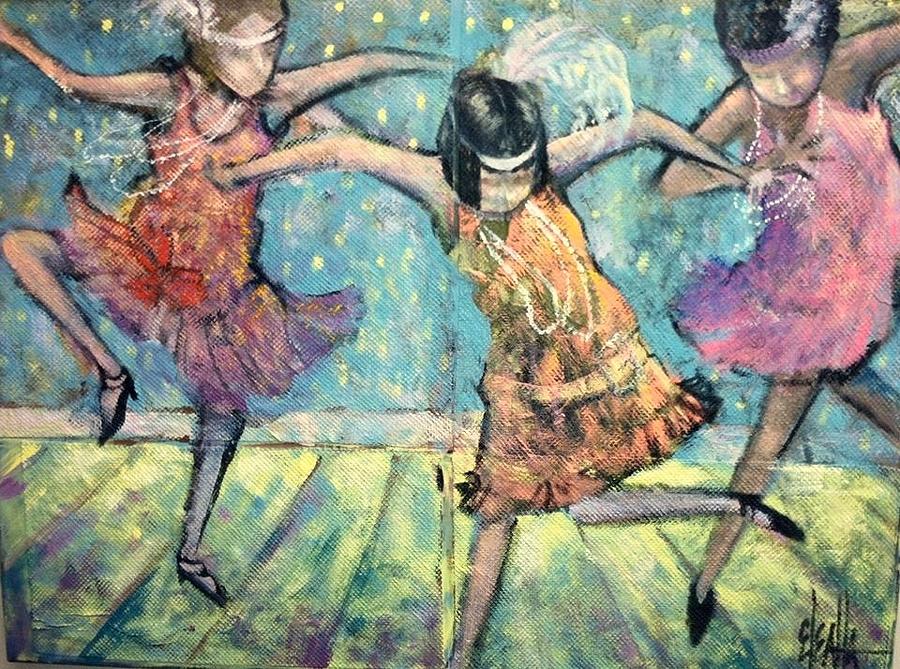Granny's Memories
Granny's toes still tap
to the music.
She is thinking about her
black flapper dress with all the fringe
around the bottom.
She was the star of the ball room once -
when she could still wear that size eight dress.
The disco ball in the nursing home spins
as the music plays.
Her memories had the same effect, of another
place in time when all the stars
twirled around in her own universe.
 Flappers -- Eleatta Diver
Flappers -- Eleatta Diver
Where There's Smoke There's Fire -- Russell Patterson
The Flapper
ReplyDeleteThe playful flapper here we see,
The fairest of the fair.
She's not what Grandma used to be, --
You might say, au contraire.
Her girlish ways may make a stir,
Her manners cause a scene,
But there is no more harm in her
Than in a submarine.
She nightly knocks for many a goal
The usual dancing men.
Her speed is great, but her control
Is something else again.
All spotlights focus on her pranks.
All tongues her prowess herald.
For which she well may render thanks
To God and Scott Fitzgerald.
Her golden rule is plain enough -
Just get them young and treat them rough
--Dorothy Parker
Flappers were young Western women in the 1920s who wore short skirts, bobbed their hair, listened to jazz, and flaunted their disdain for "acceptable behavior" by driving automobiles, engaging in sports, wearing excessive makeup, drinking, smoking, and treating sex in a casual manner. In the early 1920s, to demonstrate their defiance of convention, stylish teenage American girls wore unfastened overshoes which flapped when they walked. The word "flapper" may also have been related to a young bird flapping its wings while learning to fly. In northern England it referred to teenage girls whose plaited pigtail "flapped" on their back; as early as 1631, a flap was a young prostitute. By the 1890s, in England, "flappers" had both connotations, and, in addition, in 1907 English actor George Graves explained it as theatrical slang for acrobatic young female stage performers. By 1910, the word was popular enough for A. E. James to begin a series of stories in the "London Magazine" about a pretty 15-year-old girl, "Her Majesty the Flapper." Before World War I, the word was generally understood to refer to high-spirited teenagers, but during the war it was extended to describe any impetuous immature woman, perhaps due to the widespread emergence of young women into the workforce. The war also eroded the class system, encouraging different classes to mingle and share their sense of freedom. And women (especially in the US, where they won the right to vote in 1920) wanted to be treated like men as they gained greater working opportunity, including traditionally male jobs.
ReplyDeleteAs they became financially independent of their fathers or husbands, they also became more important as consumers. In addition to their irreverent behavior, flappers were known for their style, which largely emerged as a result of French fashions, especially those pioneered by Coco Chanel, the effect on dress of the rapid spread of American jazz, and the popularization of dancing that accompanied it. Flapper style (called "la garçonne" [boy, with a feminine suffix] in French), made girls look young and boyish: short hair, flattened breasts, and straight waists accentuated it; the flappers also removed the corset from female fashion in favor of simple bust bodices to restrain their chest when dancing, and pantaloons were replaced by "step-in" panties. The Symington Side Lacer was invented to pull in the back to flatten the chest and became a popular bra. Flapper dresses were straight and loose, leaving the arms bare (sometimes with no straps at all) and dropping the waistline to the hips. Silk or rayon stockings were held up by garters. They also raised hemlines; by 1927, skirts rose to just below the knee by 1927, allowing flashes of leg to be seen when a girl danced or walked through a breeze, although the way they danced made any long loose skirt flap up to show their legs. To enhance the view, some flappers applied rouge to their knees. High heels also came into vogue, reaching 2–3 in (5–8 cm). The rise of the automobile was an important factor as well, since having a car meanst women could come and go as they pleased. In the US, popular contempt for Prohibition (of alcohol) was an additional factor, as back-alley speakeasies became prolific. "Petting parties" or "necking parties," where foreplay or "making out" was the main attraction, became popular. The first American appearance of the word and image was the popular 1920 film, "The Flapper," starring Olive Thomas, who continued to play the part in later films as well. Soon, the flappers became associated with the new, "shocking" dance styles such as the Charleston, the Shimmy, the Bunny Hug, and the Black Bottom. American writers like F. Scott Fitzgerald and Anita Loos, and illustrators such as Russell Patterson, further popularized the flapper look and lifestyle, and later, Betty Boop, an animated cartoon character invented in 1930 by Max Fleischer as a caricature of a flapper, became an icon of the 1920s. In 1922, on the opening page of its first issue, a small-circulation magazine, "The Flapper," declared their break with traditional values. In a lecture on the surplus of young women due to the loss of young men in the war, R. Murray-Leslie described "the frivolous, scantily-clad, jazzing flapper, irresponsible and undisciplined, to whom a dance, a new hat, or a man with a car, were of more importance than the fate of nations." However, the flapper lifestyle disappeared with the onset of the Great Depression in 1929 and its economic hardship.
ReplyDelete